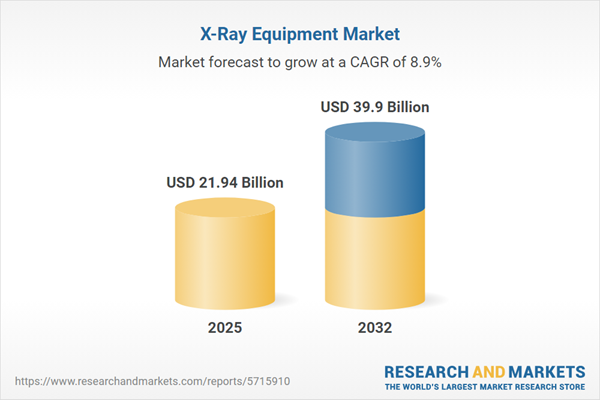Speak directly to the analyst to clarify any post sales queries you may have.
The X-Ray Equipment Market is experiencing significant transformation as healthcare, industrial, and security sectors increasingly depend on advanced imaging technologies and intelligent workflow solutions. In this evolving landscape, decision-makers must understand emerging trends, supply chain impacts, and technological advances to sustain competitiveness and guide investment.
Market Snapshot: X-Ray Equipment Market Growth and Trends
The X-Ray Equipment Market grew from USD 20.14 billion in 2024 to USD 21.94 billion in 2025. It is expected to continue growing at a CAGR of 8.92%, reaching USD 39.90 billion by 2032. Drivers include accelerated adoption of digital radiography, mounting regulatory attention to safety, and increasing demand from both medical diagnosis and non-destructive industrial inspection. Advancements in artificial intelligence, detector technologies, and workflow integration are redefining user expectations, while global supply chain changes reshape sourcing and production models across key regions.
Scope & Segmentation
- Product Types: Computed Radiography (24x30 cm imaging plate systems, 35x43 cm imaging plate systems), Conventional Radiography (film and screen-film systems including general and mammography), Digital Radiography (tethered and wireless flat panel detectors), and Portable X-Ray Systems (battery-powered and corded handheld devices, advanced and standard mobile carts).
- Applications: Industrial (material testing, non-destructive testing, pipeline inspection, weld inspection), Medical (chest, dental, general, mammography, orthopedic radiography with subcategories for extraoral, intraoral, digital, and film), and Security (airport screening, customs inspection, event security).
- End Users: Academic and research institutes, clinics, diagnostic centers (hospital-affiliated, standalone imaging centers), government and private hospitals.
- Technology: Computed radiography with imaging plates, digital radiography with CMOS, direct and indirect architectures, TFT detectors, and legacy/non-screen film systems.
- Regions: Americas (North and Latin America), EMEA (Europe, Middle East, and Africa), and Asia-Pacific, including developed and emerging sub-regions.
Key Takeaways for Decision-Makers
- Strategic differentiation is increasingly based on wireless detector integration, cloud connectivity, and robust artificial intelligence features for streamlined diagnostics and inspection.
- Industry players are intensifying R&D in materials science and modular architectures, enabling adaptability and resilience when facing material shortages or regulatory updates.
- Service and training offerings have become essential for customer retention, especially as equipment complexity and remote deployment needs rise in underserved regions.
- Regional market strategies benefit from tuning portfolios to local demand, with cost-effective digital platforms favored in Asia-Pacific and AI-enhanced systems gaining traction in North America and Europe.
- Collaboration among OEMs, component suppliers, and software developers is accelerating time to market for new solutions and enabling rapid response to regulatory and technological changes.
Tariff Impact and Supply Chain Strategy
The introduction of new United States tariffs in 2025 has significantly influenced sourcing and manufacturing strategies within the X-Ray Equipment Market. Companies are reassessing supplier networks, pursuing nearshoring to reduce tariff exposure, and diversifying component inputs. Modular design and just-in-case inventory practices are gaining traction, while localized manufacturing hubs are shortening delivery times and strengthening resilience against global trade volatility.
Methodology & Data Sources
This report synthesizes extensive secondary research with expert interviews, regulatory filings, and technical papers to ensure comprehensive analysis. Data triangulation and segmentation validation underpin the findings, while real-world perspectives from clinical and industrial end-users provide actionable insight. Peer review and scenario modeling further support the rigor of the results.
Why This Report Matters
- Empowers senior leaders with clear strategies to navigate evolving compliance, technology, and market access issues in the X-Ray Equipment Market.
- Facilitates capital allocation with granular segmentation and regional insights for effective portfolio planning and expansion.
- Supports operational resilience through in-depth analysis of tariff impacts, supply chain resilience, and risk mitigation tactics.
Conclusion
The X-Ray Equipment Market is evolving rapidly, with sustained innovation, regulatory adjustment, and intensifying global competition shaping opportunities and risks. This report equips decision-makers with relevant insights to drive strategic growth and strengthen competitive positioning amid sector transformation.
Additional Product Information:
- Purchase of this report includes 1 year online access with quarterly updates.
- This report can be updated on request. Please contact our Customer Experience team using the Ask a Question widget on our website.
Table of Contents
3. Executive Summary
4. Market Overview
7. Cumulative Impact of Artificial Intelligence 2025
Companies Mentioned
The companies profiled in this X-Ray Equipment market report include:- GE HealthCare Technologies Inc.
- Siemens Healthineers AG
- Koninklijke Philips N.V.
- Canon Medical Systems Corporation
- FUJIFILM Holdings Corporation
- Shimadzu Corporation
- Carestream Health, Inc.
- Hitachi, Ltd.
- Neusoft Medical Systems Co., Ltd.
- United Imaging Healthcare Co., Ltd.
Table Information
| Report Attribute | Details |
|---|---|
| No. of Pages | 180 |
| Published | October 2025 |
| Forecast Period | 2025 - 2032 |
| Estimated Market Value ( USD | $ 21.94 Billion |
| Forecasted Market Value ( USD | $ 39.9 Billion |
| Compound Annual Growth Rate | 8.9% |
| Regions Covered | Global |
| No. of Companies Mentioned | 11 |









